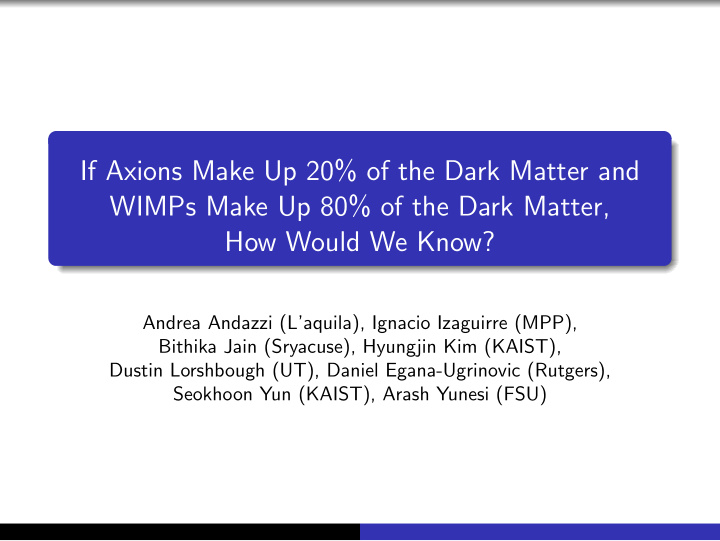



If Axions Make Up 20% of the Dark Matter and WIMPs Make Up 80% of the Dark Matter, How Would We Know? Andrea Andazzi (L’aquila), Ignacio Izaguirre (MPP), Bithika Jain (Sryacuse), Hyungjin Kim (KAIST), Dustin Lorshbough (UT), Daniel Egana-Ugrinovic (Rutgers), Seokhoon Yun (KAIST), Arash Yunesi (FSU)
The Axion: Basics QCD has a CP violating term, the θ angle. To solve this problem, we promote that angle to a dynamical field. PQ axion: Goldstone of spontaneously broken PQ symmetry. The axion is a pseudoscalar field with couplings to gauge fields g 2 a µν ˜ G b G b µν L a ⊃ (1) 32 π 2 f a
Globular Cluster M3, White Dwarf Cooling, SN 1987A 1 M3 M3 White Dwarf Luminousity Function SN1987A SN1987A SN1987A
Axions Experimental Bounds Astrophysics: Globular Clusters (Sun), Cooling of White Dwarfs, Supernovae (SN 1987A) Direct detection: CAST, ADMX
Axion Cosmology There are two main transitions that determine the cosmological axion properties: The breaking of the PQ symmetry → the axion is the massless 1 angular degree of freedom a = θ f a The QCD phase transition → the axion gets a mass from 2 nonperturbative effects.
The PQ Phase Transition Once the PQ symmetry is broken, the evolution of the zero mode of the axion is given by ¨ θ + 3 H ˙ θ + m 2 a ( T ) θ = 0 (2) Note that before the QCD transition, m a = 0 so the solution is θ = constant . The PQ phase transition can happen during or after inflation.
The QCD Phase Transition After the QCD phase transition, the axion develops a potential. V eff ∝ g 2 a G b µν > µν ˜ < G b (3) f a G b µν > is a periodic gauge configuration in a . µν ˜ where < G b The axion minimizes the potential energy at a CP conserving point. From this potential the axion gets a mass (KSVZ model) m a = 6 . 3[ eV ]10 6 [ GeV ] (4) f a
PQ Breaking After Or Before Inflation? If the PQ symmetry is broken during inflation, one particular random value of θ is seen across all our observable universe. In this case, the main constrains come from isocurvature perturbations. If it is broken after inflation, there are no isocurvature perturbations, and the initial oscillation amplitude is θ ≈ 1
Relic Density The relic density is set by the vacuum misalignment mechanism in both cases. After the QCD phase transition the zero mode of the axion oscillates as f a θ cos ( m a t ). This sets the relic density fraction to be � 1 . 19 � f θ 2 Ω a = 0 . 055 (5) 10 11 [ GeV ]
Axion relic density case 1, PQ broken after inflation If PQ is broken after inflation, recall that θ = 1. If we assume θ = 1, we obtain f ≈ 3 · 10 11 GeV ( m a ≈ 20 µ eV) for 20% dark matter. (This is on the border of the ADMX exclusion.)
Isocurvature Perturbation Constraints Figure Credit: Wayne Hu All DM Axions, fa =const Fraction DM Axions, fa = fa ( t ) Visinell and Gondolo (1403.4594) Choi, Jeong, and Seo (1404.3880)
The other 80%: the WIMPS To have a thermal WIMP relic density of order 80%, we need a WIMP annihilation xsec of order < σ v > ≈ 3 · 10 − 26 [ cm 3 / s ]. The annihilation xsec is probed in indirect detection experiments.
Conclusions If Axions Make Up 20% of the Dark Matter and WIMPs Make Up 80% of the Dark Matter, How Would We Know? If PQ symmetry is broken DURING/BEFORE inflation, isocurvature constraints force f a ( t ) and Ω a < Ω DM . For the example shown of at most Ω a / Ω DM � 10%, the theory is beyond the reach of the ADMX experiment. With PQ breaking AFTER inflation, the smoking gun signatures for 20% axionic dark matter and 80% WIMP DM would be a signal from ADMX around f a = 3 · 10 11 GeV plus a signal from WIMP indirect detection experiments at < σ v > ≈ 10 − 26 [ cm 3 / s ].
Thank You!
Recommend
More recommend